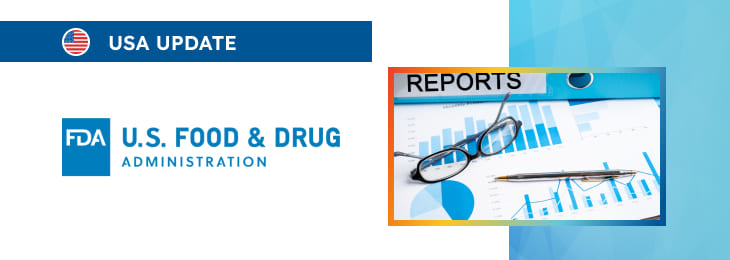The final article of the cycle provides additional clarifications regarding the matters related to data reporting.

Table of content
The Food and Drug Administration (FDA or the Agency), the US regulating authority in the sphere of healthcare products, has published a draft guidance document dedicated to chemical analysis for biocompatibility assessment of medical devices. Once finalized, the guidance will provide an overview of the applicable regulatory requirements, as well as additional clarifications and recommendations to be taken into consideration by medical device manufacturers and other parties involved in order to ensure compliance.
At the same time, provisions of the guidance are non-binding in their legal nature, nor are they intended to introduce new rules or impose new obligations. Moreover, the authority explicitly states that an alternative approach could be applied, provided such an approach is in line with the underlying legislation and has been agreed with the authority in advance.
General Recommendations for Data Reporting
According to the document, when submitting analytical chemistry testing information, it is recommended to provide complete test reports for all tests conducted. These reports should summarize the methods used, as described in ISO 10993-18, and clearly indicate any protocol deviations and their impact on the test conclusions.
Details on proper test reporting are provided in Appendix D of the document and Attachment E of the FDA’s biocompatibility guidance.

Key Elements of the Test Report
As further explained by the FDA, the test report should include the following:
- Summary of the Test Method: An overview of the analytical methods employed, including any modifications from standard protocols.
- Results of the Testing: A detailed presentation of the findings, including all relevant quantitative data and qualitative observations.
- Protocol Deviations: Any deviations from the test procedure should be reported, along with an explanation of their potential impact on the validity of the test results.
In such a way, test reports will provide a comprehensive view of the analytical testing, ensuring that the data submitted is reliable and transparent.
Reporting Thresholds and Analytical Evaluation Threshold (AET)
The Analytical Evaluation Threshold (AET) is used to determine the reporting threshold for extractables in device materials. The AET calculation should clearly describe the value used for each variable and justify the selection of C and DBT based on the device’s intended use and duration of exposure.
For example, a DBT based on a 1.5 μg/day Threshold of Toxicological Concern (TTC) is recommended for devices with extended tissue contact (30 days or more).
Method Justification
The method used for chemical analysis should be justified based on its ability to identify and quantify analytes above the reporting threshold.
The following points should be addressed:
- Extraction Conditions: The extraction methods should generate extracts that accurately reflect potential tissue exposure. Overly mild extraction conditions may result in an underestimation of the chemical load.
- Analytical Sensitivity: The sensitivity of the analytical method must be sufficient to detect and quantify all analytes above the reporting threshold, avoiding underestimation.
- System Suitability and Calibration: Proper system setup and calibration should be demonstrated, confirming that the methods are functioning as expected throughout the analysis.
- Identification Confidence: The confidence levels for chemical identifications (e.g., unknown, tentative, confident, confirmed) should be justified, using Quality Assurance/Quality Control (QA/QC) approaches.
Extraction Conditions and Results
According to the guidance, the information to be provided by the party responsible for a chemical analysis should also address the following aspects:
Extraction Conditions. The test report should provide details about the extraction conditions used, including:
- Identity of the extraction vehicles (solvents).
- Number of replicate extractions per solvent.
- Number of test articles used in each extraction.
- Surface area or weight of each test article.
- Volume of solvent used, with confirmation that the test article is fully submerged.
- Extraction temperature.
- Number and duration of extraction cycles.
- Physical appearance of the extract and test articles before and after extraction (e.g., color changes, increases in turbidity, particulates, or test article integrity changes).
NVR Analysis. For Non-Volatile Residue (NVR) analysis, the following should be reported:
- Number of replicates.
- Extraction cycle time and temperature.
- Volume of extract used for analysis.
- Drying parameters (time, temperature, pressure).
- Method precision and sensitivity in units of mass/device. NVR expressed in total mass for the sample and per device for each replicate.
System Information
The analytical system setup should be described in detail, including:
- Instrumentation type and configuration.
- Chromatography conditions (e.g., mobile phase gradient, flow rate, run time).
- Detection method parameters and ionization settings.
- Calibration data, such as calibration curves, statistics, and chromatographic details.
Calibration Data
Sufficient data should be presented to demonstrate the suitability of the calibration method, including:
- Calibration curves in graphical format.
- Calibration equations and fit statistics.
- Chromatograms to demonstrate integration of calibration points.
Chromatographic Data
The test report should include labeled chromatograms for GC-MS and LC-MS, with relevant peaks above the AET clearly marked for easy cross-referencing with tabulated results.
Extractable Identities and Amounts
For each solvent used, a table of identified and quantified extractables should be provided, including:
- Retention Time (RT).
- Chemical name and Chemical Abstracts Service Registry Number (CASRN), if available.
- Structural descriptors or images (e.g., SMILES).
- Major ions observed (m/z).
- Type of data used for identification.
- Confidence level of identification.
- Amount in μg/device.
- Extraction iteration (if not pooled).
Elemental Analysis Reporting
For elemental analysis using methods like ICP-MS, all naturally occurring elements should be listed, indicating which elements were analyzed and reporting their concentrations. Sensitivity should be ensured for accurate reporting below the relevant toxicological thresholds.
Conclusion
In summary, the present FDA guidance outlines detailed reporting guidelines; manufacturers can ensure that the analytical data submitted provides a complete and accurate representation of the chemical profile of the device. This enables a thorough safety evaluation and supports the biocompatibility assessment process.
How Can RegDesk Help?
RegDesk is an AI-powered Regulatory Information Management System that provides medical device companies with regulatory intelligence for over 120 markets worldwide. It can help you prepare and publish global applications, manage standards, run change assessments, and obtain real-time alerts on regulatory changes through a centralized platform. Global expansion has never been this simple.

